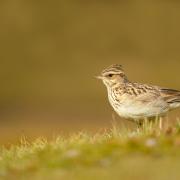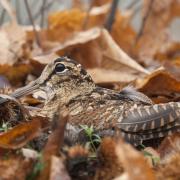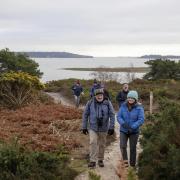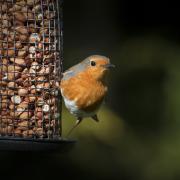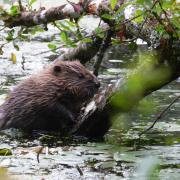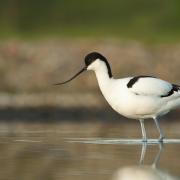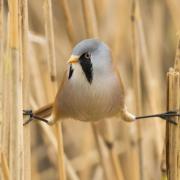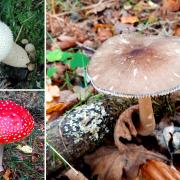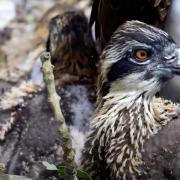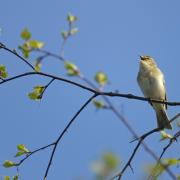Stags, spiders and spoonbills, Morwenna Alldis from the RSPB South West, reveals the star turns you can admire at RSPB Arne nature reserve this autumn

1. Sika Deer
A large herd of wild non-native Sika Deer live at RSPB Arne and from October the stags start to vocally and physically battle it out for the females during the annual rut. With their guard down this is a great time of year to see them in the open.
• Key Features: Similar size to fallow deer, but with a darker, reddish-brown/yellow-brown coat. Antlers are branched and typically have eight points.
• Sika Courting Rituals: After creating a shallow scrape in the ground, the males use this as a toilet before rolling in its contents. With their new cologne applied, they are ready for the girls and call for them – this sounds like a mix between a scream and a squeaky gate. At RSPB Arne the males like to be seen, so prefer using our farm fields to hold territory and most of the fights between rival males occur here.

2. Raft Spider
One of the UK’s largest spiders, these arachnids evade predators by silently slipping under the surface of RSPB Arne’s heathland ponds.
Find them on the edge of the ponds or floating on the surface on plant debris - waiting to feel the vibrations in the water from their prey (tadpoles and small fish).
Then they pounce!

3. Spoonbills
RSPB Arne is home to the largest flock of wintering spoonbills in the UK. In 2015, 60 birds were counted in Poole Harbour feasting on aquatic insects and small fish.
• Key Features: This large bird is comparable in size to a grey heron, and has long black legs and a white body. They fly with their necks and legs extended. As their name suggests they use their long, black, flat-ended bill to spoon prey out of the water. With a side-to-side sweeping motion they partially submerge their beaks and when they feel a meaty morsel enter their bill, they scoop it out of the water and devour it.
• Did you know: During the breeding season the tip of their bills, breast and white feathered crest grow a mustard tinge.

4. Black-tailed Godwits
RSPB Arne is home to over a 1000 wintering black-tailed godwits, which travel here from Iceland. They are viewable from Coombe Heath, in the Middlebeare Channel.
• Key Features: Long legs and grey-brown plumage with decorative black and white stripes across their wings. Typically they make a ‘kik’ or ‘kik-ki’ call when in their graceful flight.
• Did you know: The impressively long, pointed beak of a godwit is always longer in the females (who are generally bigger and heavier). These extra beak inches mean the female forages at a deeper depth than the male, allowing dinner to be shared more equally.

5. Wasp Spider
This vividly coloured continental newcomer is now one of the UK’s largest spiders and it can be found on and around our heathland ponds at RSPB Arne.
• Key Features: Its striking black, white and yellow stripes warn off predators. Look out for their large, orb-shaped webs in heathland and grassland.
• Did you know: During mating season the males wait it out on the edge of the female’s web, until she’s fully moulted – at which point her jaws are soft. The males then rush in and get the job done when she’s relatively unarmed. Sadly not many males escape uneaten by their one-night stand!

6. Hen Harrier
These rare birds of prey overwinter at RSPB Arne. Across England there are enough habitats to support over 300 pairs of hen harriers, but because of human persecution, especially on grouse moors, only a handful of breeding pairs remain.
• Key Features: Males are a pale grey colour; females and juveniles are brown with a white rump and long barred tail. They eat small birds such as meadow pipits and small mammals including voles. When hunting they pull their wings in to form a tight V shape and fly low so as to hug the land and dive for dinner.
• Did you know: Males guard a territory of around 2.6km and can mate with up to five females during one season.

7. Dark-bellied Brent Geese
These visitors migrate to RSPB Arne nature reserve from Siberia and are the smallest goose to visit the UK. There are three sub-species of Brent geese, dark-bellied, pale-bellied and black. They fly in loose flocks along our coasts, as opposed to the tight V formations of grey geese. See them from Coombe Heath, in the Middlebeare Channel, in groups of over 1000 where they are feeding on inter-tidal eel grass and coastal vegetation including green algae.
• Key Features: Same size as a mallard duck with a black head and neck, greyish-brown back and in this case a darker underbelly.
• Did you know: ‘Brent’ is from the Norse word ‘brand’ which means ‘burnt’ and reflects their charcoal-like colouring. In their lifetime, which can be up to 27 years, they can travel over 135,000 miles.
More…
• The history in the hedges at Dorset Wildlife Trust’s Kingcombe reserve - The hedges at Dorset Wildlife Trust’s Kingcombe reserve are living boundaries, wildlife corridors, feeding stations and a fascinating document of the past, says Hester Lacey








